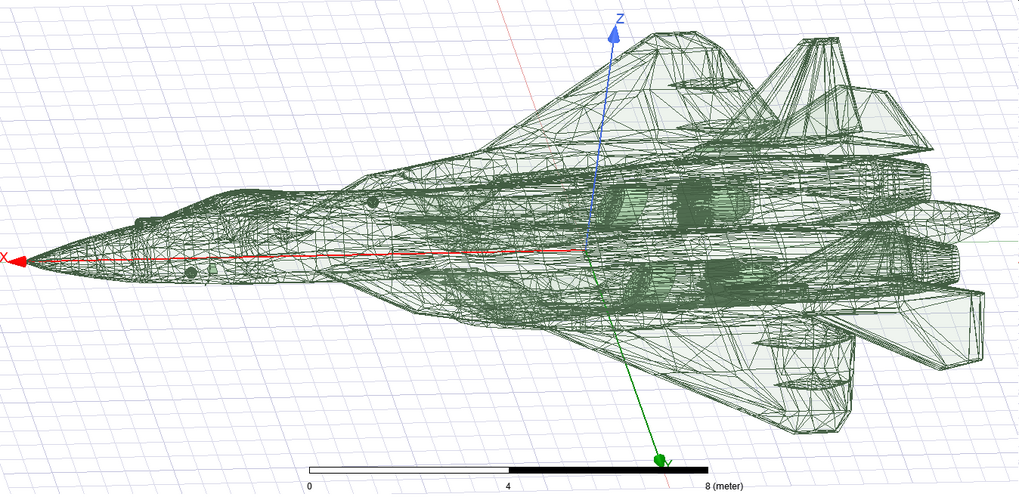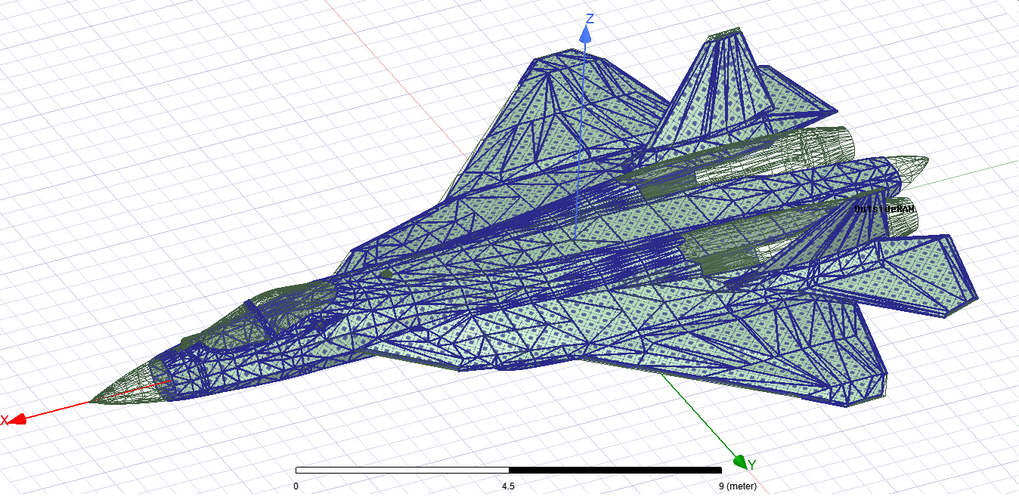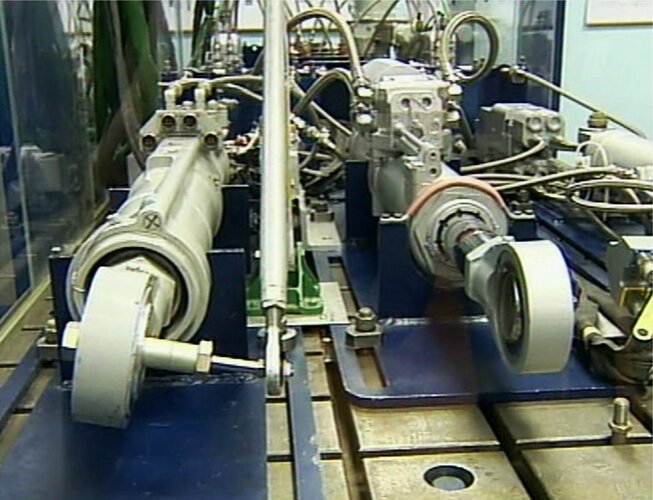You are using an out of date browser. It may not display this or other websites correctly.
You should upgrade or use an alternative browser.
You should upgrade or use an alternative browser.
Sukhoi Su-57 / T-50 / PAK FA - flight testing and development Part II [2012-current]
Attachments
- Joined
- 11 February 2010
- Messages
- 1,558
- Reaction score
- 2,354
I noticed the additional fins below the H-stab.
QuadroFX
Russia, Chelyabinsk
Which is optional according to description of patent:I noticed the additional fins below the H-stab.
[...]В качестве дополнительного средства повышения устойчивости на хвостовых балках фюзеляжа могут быть установлены неподвижные под фюзеляжные гребни 11, плоскость хорд которых формирует угол с вертикальной плоскостью самолета.[...]
QuadroFX
Russia, Chelyabinsk
From this patent:Still hard to understand why do they need a double seater.
[...]Возможность использования двухместного многофункционального самолета в качестве воздушного пункта управления, с возможностью обеспечения взаимодействия между авиационными и войсковыми формированиями при решении боевых задач, проведения анализа информации, поступающей от собственных систем и внешних источников информации с последующей выдачей рекомендаций экипажу и команд самолетам группы, а также в качестве пункта управления беспилотными летательными аппаратами, достигается за счет широкой номенклатуры средств связи, включающей в себя спутниковую связь, оборудование для групповой передачи информации, оборудование для передачи информации на большие удаления и высокоскоростного канала связи для получения и передачи аудио, фото, видео, текстовой, голосовой и телекодовой информации и специализированного командно-информационного поля задней кабины экипажа, (который, по сравнению с передней кабиной имеет следующие отличия: расширенный панорамный авиационный индикатор и дополнительный индикатор для увеличения рабочего поля оператора, устанавливается органы управления для передачи приоритета управления из одной кабины в другую, а также исключаются органы правления, не требующие управления вторым членом экипажа), что позволяет в оперативном режиме получать информацию из различных внешних источников (как авиационных, так и сухопутных и морских), проводить ее анализ на борту самолета и выдавать рекомендации или команду на выполнение боевой задачи самолетам группы с учетом их запаса топлива и боевого оснащения.[...]
- Joined
- 11 February 2010
- Messages
- 1,558
- Reaction score
- 2,354
I'm curious if there is any studies or papers from Russia on utilization of Radar absorbers, be it RAM paint or RAS (Radar Absorber Structure). Knowing that Su-57 skin is like 20% composite by weight yet about 70% by surface area makes me think that, the composite skin could host some RCS reduction means.
I have been fixated on absorber paint for a while, which kinda forgetting the Radar Absorber Structure and the composite skin is also a RAS (previously i thought it's something like Bulkhead etc) But anyway. been trying to figure some scheme on possible layout of Su-57 coating, the wide area application of the composite kinda make me think something like this.

So basically the Absorber paint would be on top of primer. The composite panel which is of honeycomb type will have some treatment in its core to provide it with absorbing ability. The face would be dielectric and matched to the primer and the RAM paint so that EM wave that managed to pass through the RAM would seamlessly enter the composite panel. The wave got absorbed then reflected by the composite's back panel which should be conductive otherwise the wave will just penetrate inside the aircraft.
The problems then would be the thickness and the electrical properties of the material. Simulating materials in software e.g Ansys or other EM solver of your choice NEEDS material's electrical properties namely :
1. Relative Permittivity (Dielectric Constant)
2. Permeability
3. At least Impedance or Resistance in case you are using POFACETS.
4. Dielectric and Magnetic tangential loss.
Commonly available research papers often specify 1 and 2 in complex notation ( x-jx) as these materials have Imaginary and Real properties (the "j" notation). They need to be solved first to get the value of Relative Permittivity and Permeability. Not all papers however specify them but instead showing Reflection loss instead which totally useless for modeling purpose.
Back to Su-57 Skin. For the purpose of modeling i selected Barium Hexaferrite playing the role as "Iron ball paint" while for the composite i choose one from a Korean research paper on RAS on honeycomb material. The model itself are as usual my old Su-57 model, it's now have more extensive RAM coverage.
Most of the body are treated except some parts, but otherwise it's almost fully covered inlet features radar blocker and wall treatment with same material. The parts that are radomes like leading edge and nose are left as PEC (Perfect Electric Conductor) as it's kinda close to FSS/bandpass radome, canopy is also left as PEC for same reason except instead of FSS it has gold or conductive coating.
The absorber specification as follows :
Barium Hexaferrite paint : 1 mm thickness.
Composite panel : 6 mm thickness.
The thickness for the paint are trial and error as too thick and the reflectivity grows or too think and it not work well with the composite. while the composite thickness are selected based on some guesstimates on Su-57 at assembly line. not really exact but possible given the apparent thickness in the available photo.
Magnetic and dielectric part are derived from papers, for example this is for the Hexaferrite paint :

Excerpt depicting the properties for the honeycomb composite absorber :

Notice the complex number notation for the permittivity.
As for comparison, the model will be compared with the Su-57 model that only use paint (3 mm for skin and 5 mm for inlet) and a clean F-16.
The result are as follows :

As can be noticed, the one with composite skin and RAM paint have lesser RCS compared to one that relies only to paint. Both aircraft however are, at least when compared to conventional, have relatively much lower RCS. The model with only paint have about 0.5 sqm in X-band while the one with both RAM paint and RAS composite absorber are 0.2-0.3 sqm.
I also would like to introduce a "new standard" that i use to present my RCS data namely "Equivalent Spherical RCS" Which a simplified representation of aircraft RCS which obtained by doubling the Median of the RCS data. I adopted this from book ""Principles of Air Defense and Air Vehicle Penetration" - Frank Heilenday (ADA375233)".
On the subject of new standard which includes some comparisons i made :
View: https://twitter.com/Flankerchan/status/1696545346825146782
This modeling attempt however are still speculative in nature, especially on the RAM and RAS composition and their electrical specifications. It could perhaps be possible to have some large values of both permittivity and permeability within the composite which could be retained for considerable amount of bandwidth. But at least it can be shown the benefit and the amount of reduction of RCS resulted from the attempt.
as a closing remarks.. Enjoy some 3D graphics of interaction between the model and the Radiowave.

I have been fixated on absorber paint for a while, which kinda forgetting the Radar Absorber Structure and the composite skin is also a RAS (previously i thought it's something like Bulkhead etc) But anyway. been trying to figure some scheme on possible layout of Su-57 coating, the wide area application of the composite kinda make me think something like this.
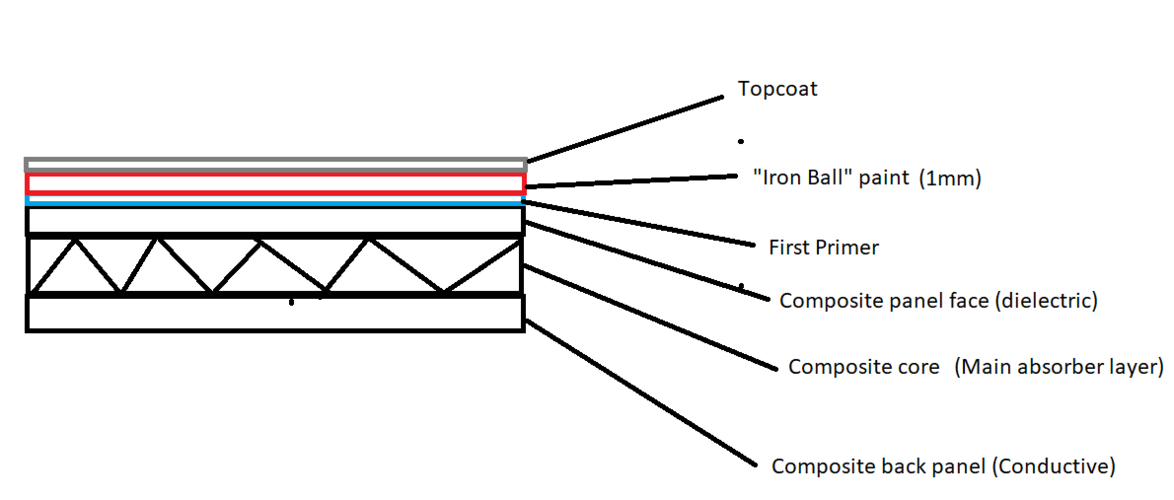
So basically the Absorber paint would be on top of primer. The composite panel which is of honeycomb type will have some treatment in its core to provide it with absorbing ability. The face would be dielectric and matched to the primer and the RAM paint so that EM wave that managed to pass through the RAM would seamlessly enter the composite panel. The wave got absorbed then reflected by the composite's back panel which should be conductive otherwise the wave will just penetrate inside the aircraft.
The problems then would be the thickness and the electrical properties of the material. Simulating materials in software e.g Ansys or other EM solver of your choice NEEDS material's electrical properties namely :
1. Relative Permittivity (Dielectric Constant)
2. Permeability
3. At least Impedance or Resistance in case you are using POFACETS.
4. Dielectric and Magnetic tangential loss.
Commonly available research papers often specify 1 and 2 in complex notation ( x-jx) as these materials have Imaginary and Real properties (the "j" notation). They need to be solved first to get the value of Relative Permittivity and Permeability. Not all papers however specify them but instead showing Reflection loss instead which totally useless for modeling purpose.
Back to Su-57 Skin. For the purpose of modeling i selected Barium Hexaferrite playing the role as "Iron ball paint" while for the composite i choose one from a Korean research paper on RAS on honeycomb material. The model itself are as usual my old Su-57 model, it's now have more extensive RAM coverage.
Most of the body are treated except some parts, but otherwise it's almost fully covered inlet features radar blocker and wall treatment with same material. The parts that are radomes like leading edge and nose are left as PEC (Perfect Electric Conductor) as it's kinda close to FSS/bandpass radome, canopy is also left as PEC for same reason except instead of FSS it has gold or conductive coating.
The absorber specification as follows :
Barium Hexaferrite paint : 1 mm thickness.
Composite panel : 6 mm thickness.
The thickness for the paint are trial and error as too thick and the reflectivity grows or too think and it not work well with the composite. while the composite thickness are selected based on some guesstimates on Su-57 at assembly line. not really exact but possible given the apparent thickness in the available photo.
Magnetic and dielectric part are derived from papers, for example this is for the Hexaferrite paint :

Excerpt depicting the properties for the honeycomb composite absorber :

Notice the complex number notation for the permittivity.
As for comparison, the model will be compared with the Su-57 model that only use paint (3 mm for skin and 5 mm for inlet) and a clean F-16.
The result are as follows :

As can be noticed, the one with composite skin and RAM paint have lesser RCS compared to one that relies only to paint. Both aircraft however are, at least when compared to conventional, have relatively much lower RCS. The model with only paint have about 0.5 sqm in X-band while the one with both RAM paint and RAS composite absorber are 0.2-0.3 sqm.
I also would like to introduce a "new standard" that i use to present my RCS data namely "Equivalent Spherical RCS" Which a simplified representation of aircraft RCS which obtained by doubling the Median of the RCS data. I adopted this from book ""Principles of Air Defense and Air Vehicle Penetration" - Frank Heilenday (ADA375233)".
On the subject of new standard which includes some comparisons i made :
View: https://twitter.com/Flankerchan/status/1696545346825146782
This modeling attempt however are still speculative in nature, especially on the RAM and RAS composition and their electrical specifications. It could perhaps be possible to have some large values of both permittivity and permeability within the composite which could be retained for considerable amount of bandwidth. But at least it can be shown the benefit and the amount of reduction of RCS resulted from the attempt.
as a closing remarks.. Enjoy some 3D graphics of interaction between the model and the Radiowave.

paralay
ACCESS: Top Secret
According to Russian experts, the RCS of fifth-generation fighter cannot be lower than 0.3 m2 due to the technical features of the design. 0.2 m2 is the level of a cruise missile and F-117
example of materials
example of materials
aonestudio
I really should change my personal text
- Joined
- 11 March 2018
- Messages
- 2,881
- Reaction score
- 7,123
- Joined
- 22 January 2006
- Messages
- 4,134
- Reaction score
- 1,751
New video with intermediate development design configurations
View: https://www.youtube.com/watch?v=5LVYjGMD_qI
Imagine landing that thing in cross wind; unles they made the lower fins foldable like the mig-23New video with intermediate development design configurations
View: https://www.youtube.com/watch?v=5LVYjGMD_qI
They haven’t shown anything about what’s displayed on the helmet right??ZSh-10 with HMD.
QuadroFX
Russia, Chelyabinsk
A one of a new batch showed up in Novosibirsk:
(-37C outside)

Official press-release soon(?)
(-37C outside)

Official press-release soon(?)
Attachments
Ainen
I really should change my personal text
- Joined
- 25 August 2011
- Messages
- 808
- Reaction score
- 952
well, according to rumors(?), 8 airframes in two batches were delivered in 2023 as of yet.A one of a new batch showed up in Novosibirsk:
(-37C outside)

Official press-release soon(?)
QuadroFX
Russia, Chelyabinsk
Seems to be right. 18 machines in total, which is not so much (
Ainen
I really should change my personal text
- Joined
- 25 August 2011
- Messages
- 808
- Reaction score
- 952
Squadron is 12, so most probably 23th IAP either already has one, or will have in the immediate future.True, but 18 planes in total might be enough that a small operational squadron always keeps a pair available for a daily combat mission.
But su-57 production goes on top of now rather substantial su-35 fleet, which is also too new&capable to be discounted.
In the global context, while Felon production isn't especially large (nor it will be), it now gives a notable 'addition' to the J-20 one.
TSARb
ACCESS: Confidential
- Joined
- 8 March 2011
- Messages
- 52
- Reaction score
- 114
Comparison by Ahriman from Paralay's forum.New video with intermediate development design configurations
View: https://www.youtube.com/watch?v=5LVYjGMD_qI
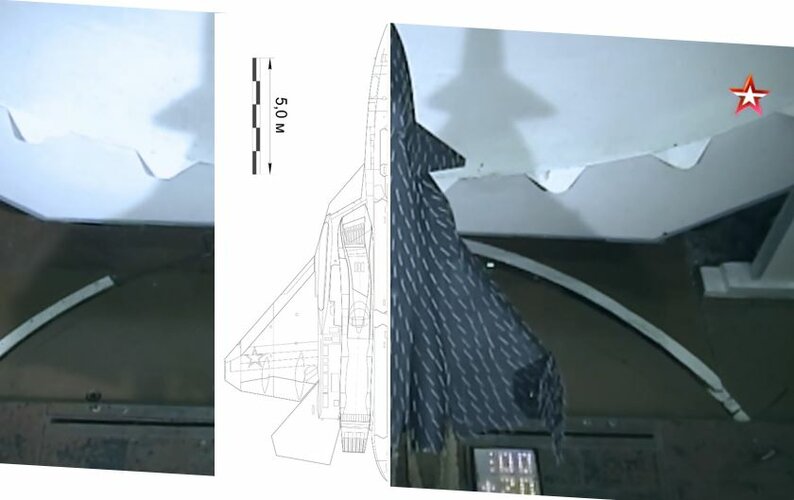
piginapoke
I really should change my personal text
- Joined
- 11 March 2013
- Messages
- 91
- Reaction score
- 112
Great video.New video with intermediate development design configurations
View: https://www.youtube.com/watch?v=5LVYjGMD_qI
QuadroFX
Russia, Chelyabinsk
A one of a new batch showed up in Novosibirsk:
(-37C outside)

Official press-release soon(?)
Attachments
TMA1
ACCESS: Top Secret
- Joined
- 6 February 2021
- Messages
- 543
- Reaction score
- 821
Awesome. Cannot wait for the izd30 and new nozzles as well as the other sensor updates.
Edit: look closely at that dark square on it's back. If you zoom in you can see the unique sawtoothing they use on the grating seen on other parts of the su-57 like behind the cannon. I do not remember seeing this particular grate before...
Edit: look closely at that dark square on it's back. If you zoom in you can see the unique sawtoothing they use on the grating seen on other parts of the su-57 like behind the cannon. I do not remember seeing this particular grate before...
Last edited:
- Joined
- 1 April 2006
- Messages
- 11,129
- Reaction score
- 8,822
More than six years passed on after Moscow major Sobyanin visited Moscow Salyut plant. Guy still thinks engine on photos from this event is Izdeliye 30 from Saturn.
Last edited:
- Joined
- 2 January 2006
- Messages
- 3,660
- Reaction score
- 3,864
This guy claims they are already using AL-51F engines allegedly based on the TASS report, but I cannot find the original file stating they can maybe be re-engined at a later stage: Can anyone find the mentioned text or correct me?
View: https://twitter.com/RupprechtDeino/status/1740425680381469003
View: https://twitter.com/RupprechtDeino/status/1740425680381469003
paralay
ACCESS: Top Secret
Source: serial Su-57s transferred to the VKS in 2024 will receive engines of the second stage
As the agency's interlocutor noted, in 2023, more than 10 Su-57s with first-stage engines have already been transferred to the Aerospace Forces
MOSCOW, December 28th. /tass/.
All serial Su-57 fighters transferred to the Russian Aerospace Forces (VKS) in 2024 will receive second-stage engines. This was reported to TASS by two high-ranking sources close to the Russian Aerospace Forces."The engine of the second stage has been tested and is ready for operation," said one of the agency's interlocutors. A second source confirmed this information and added that "all production aircraft of the fifth generation Su-57, transferred to the VKS in 2024, will receive a fifth-generation engine."TASS has no official confirmation of this information.According to the agency interlocutor, in 2023, more than 10 Su-57s with engines of the first stage have already been transferred to the VKS. They successfully solve tasks in the zone of a special military operation.

Источник: передаваемые ВКС в 2024 году серийные Су-57 получат двигатели второго этапа
Как отметил собеседник агентства, в 2023 году Воздушно-космическим силам уже передали более 10 Су-57 с двигателями первого этапаtass.ru
According to the plan, 12 Su-57s should be transferred in 2024
Nonsense.This guy claims they are already using AL-51F engines allegedly based on the TASS report, but I cannot find the original file stating they can maybe be re-engined at a later stage: Can anyone find the mentioned text or correct me?
View: https://twitter.com/RupprechtDeino/status/1740425680381469003
The TASS article is clear: until now, all production aircraft have AL-41F1 engines installed, and from the new year all will have AL-51F1. Dot.
If the source was right, we will see in the next few months.
I wonder if the new engines will necessitate changing the intakes and/or the airframe. With the J-20, it definitely seemed to be the case.
On an unrelated note - does anyone know if the Su-57 uses hydraulic actuators or does it have electric/electrohydraulic ones?
On an unrelated note - does anyone know if the Su-57 uses hydraulic actuators or does it have electric/electrohydraulic ones?
paralay
ACCESS: Top Secret
LMFS
ACCESS: Top Secret
- Joined
- 19 March 2019
- Messages
- 525
- Reaction score
- 846
Open question to the gentlemen here: does this announcement of deliveries with the second stage engines already in 2024 indicates that the rest of the improvements slated for the M version are going into the series too?
paralay
ACCESS: Top Secret
Why improve it, it's already perfect! 
LMFS
ACCESS: Top Secret
- Joined
- 19 March 2019
- Messages
- 525
- Reaction score
- 846
It can be even more perfect xDWhy improve it, it's already perfect!
paralay
ACCESS: Top Secret
paralay
ACCESS: Top Secret
Лучше - враг хорошего / Better is the enemy of goodIt can be even more perfect xD
Similar threads
-
Sukhoi PAK FA news and speculation (T-50, I-21) Part II [2008-2009]
- Started by overscan (PaulMM)
- Replies: 451
-
Sukhoi Su-57 / T-50 / PAK FA first flight - pictures, videos and analysis [2010]
- Started by flateric
- Replies: 872
-
Sukhoi Su-57 / T-50 / PAK FA - flight testing and development Part I [2010-2012]
- Started by Matej
- Replies: 760
-
Sukhoi PAK FA news and speculation (T-50, I-21) Part I [2006-2008]
- Started by overscan (PaulMM)
- Replies: 455
-
Vladimir Sergeevich Ilyushin 31-03-1927 - 01-03-2010
- Started by flateric
- Replies: 4





